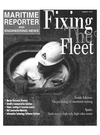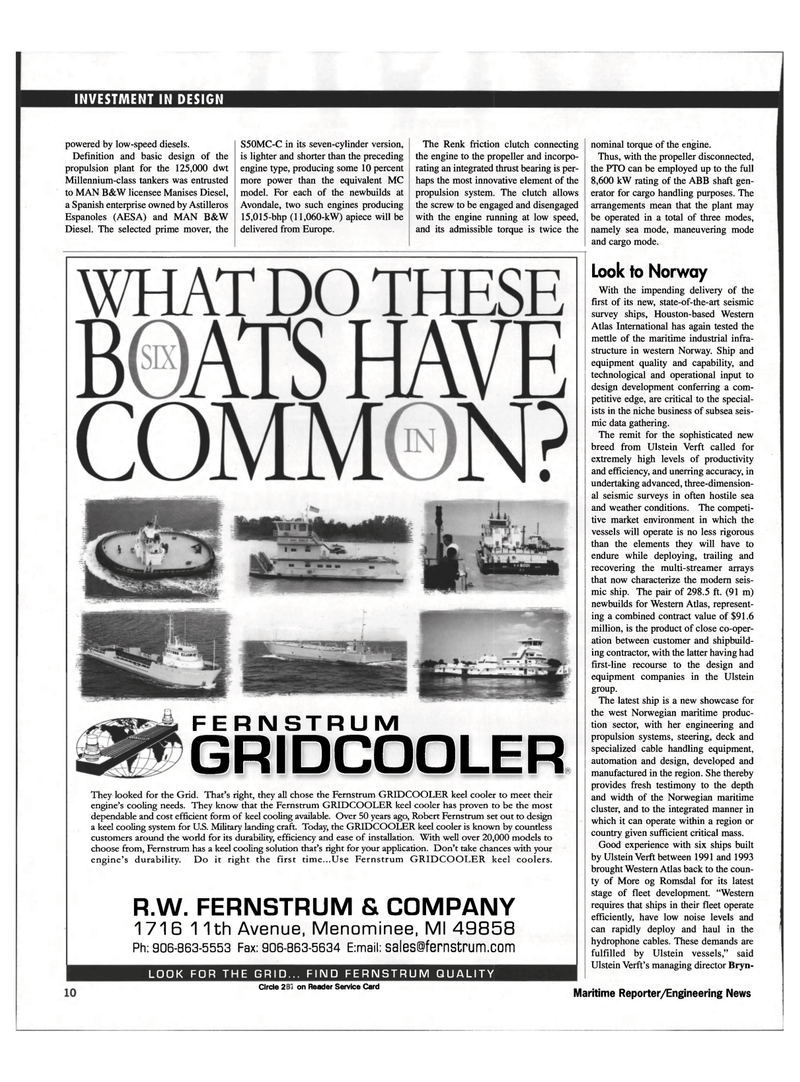
Page 10: of Maritime Reporter Magazine (March 1999)
Read this page in Pdf, Flash or Html5 edition of March 1999 Maritime Reporter Magazine
INVESTMENT IN DESIGN
LOOK FOR THE GRID... FIND FERNSTRUM QUALITY
They looked for the Grid. That's right, they all chose the Femstrum GRIDCOOLER keel cooler to meet their engine's cooling needs. They know that the Femstrum GRIDCOOLER keel cooler has proven to be the most dependable and cost efficient form of keel cooling available. Over 50 years ago, Robert Femstrum set out to design a keel cooling system for U.S. Military landing craft. Today, the GRIDCOOLER keel cooler is known by countless customers around the world for its durability, efficiency and ease of installation. With well over 20,000 models to choose from, Femstrum has a keel cooling solution that's right for your application. Don't take chances with your engine's durability. Do it right the first time...Use Femstrum GRIDCOOLER keel coolers.
R.W. FERNSTRUM & COMPANY 1716 11th Avenue, Menominee, Ml 49858
Ph: 906-863-5553 Fax: 906-863-5634 Email: [email protected] powered by low-speed diesels.
Definition and basic design of the propulsion plant for the 125,000 dwt
Millennium-class tankers was entrusted to MAN B&W licensee Manises Diesel, a Spanish enterprise owned by Astilleros
Espanoles (AESA) and MAN B&W
Diesel. The selected prime mover, the
S50MC-C in its seven-cylinder version, is lighter and shorter than the preceding engine type, producing some 10 percent more power than the equivalent MC model. For each of the newbuilds at
Avondale, two such engines producing 15,015-bhp (11,060-kW) apiece will be delivered from Europe.
Circle 243 on Reader Service Card
The Renk friction clutch connecting the engine to the propeller and incorpo- rating an integrated thrust bearing is per- haps the most innovative element of the propulsion system. The clutch allows the screw to be engaged and disengaged with the engine running at low speed, and its admissible torque is twice the nominal torque of the engine.
Thus, with the propeller disconnected, the PTO can be employed up to the full 8,600 kW rating of the ABB shaft gen- erator for cargo handling purposes. The arrangements mean that the plant may be operated in a total of three modes, namely sea mode, maneuvering mode and cargo mode.
Look to Norway
With the impending delivery of the first of its new, state-of-the-art seismic survey ships, Houston-based Western
Atlas International has again tested the mettle of the maritime industrial infra- structure in western Norway. Ship and equipment quality and capability, and technological and operational input to design development conferring a com- petitive edge, are critical to the special- ists in the niche business of subsea seis- mic data gathering.
The remit for the sophisticated new breed from Ulstein Verft called for extremely high levels of productivity and efficiency, and unerring accuracy, in undertaking advanced, three-dimension- al seismic surveys in often hostile sea and weather conditions. The competi- tive market environment in which the vessels will operate is no less rigorous than the elements they will have to endure while deploying, trailing and recovering the multi-streamer arrays that now characterize the modern seis- mic ship. The pair of 298.5 ft. (91 m) newbuilds for Western Atlas, represent- ing a combined contract value of $91.6 million, is the product of close co-oper- ation between customer and shipbuild- ing contractor, with the latter having had first-line recourse to the design and equipment companies in the Ulstein group.
The latest ship is a new showcase for the west Norwegian maritime produc- tion sector, with her engineering and propulsion systems, steering, deck and specialized cable handling equipment, automation and design, developed and manufactured in the region. She thereby provides fresh testimony to the depth and width of the Norwegian maritime cluster, and to the integrated manner in which it can operate within a region or country given sufficient critical mass.
Good experience with six ships built by Ulstein Verft between 1991 and 1993 brought Western Atlas back to the coun- ty of More og Romsdal for its latest stage of fleet development. "Western requires that ships in their fleet operate efficiently, have low noise levels and can rapidly deploy and haul in the hydrophone cables. These demands are fulfilled by Ulstein vessels," said
Ulstein Verft's managing director Bryn- 12 Maritime Reporter/Engineering News
FERNSTRUM GRIDCOOLER

 9
9

 11
11
